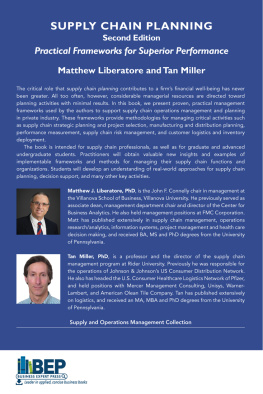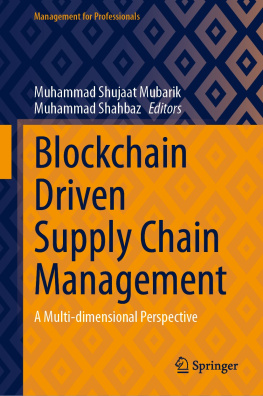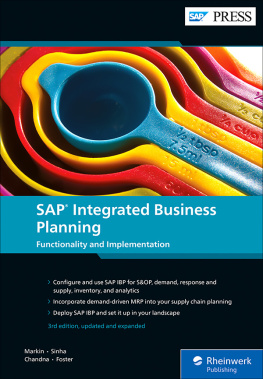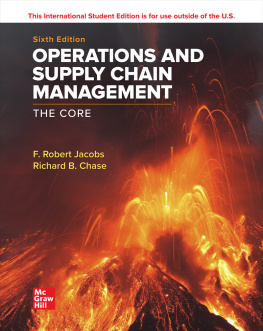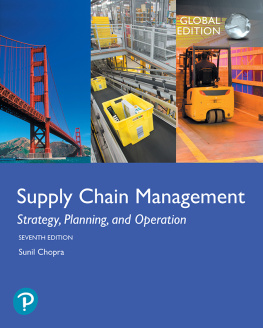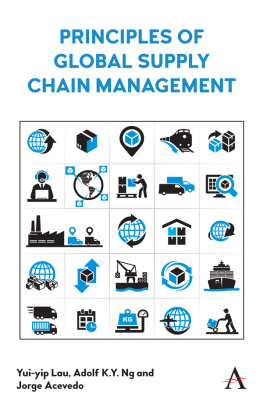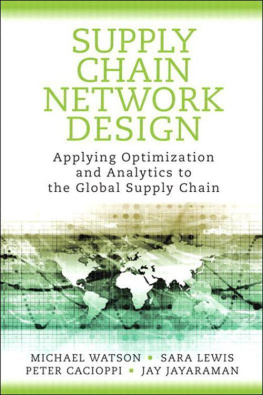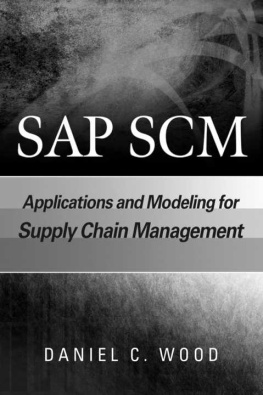Supply Chain Planning
Supply Chain Planning
Practical Frameworks for Superior Performance
Second Edition
Matthew J. Liberatore
Tan Miller

Supply Chain Planning, 2E: Practical Frameworks for Superior Performance
Copyright Business Expert Press, LLC, 2021.
All rights reserved. No part of this publication may be reproduced, stored in a retrieval system, or transmitted in any form or by any meanselectronic, mechanical, photocopy, recording, or any other except for brief quotations, not to exceed 250 words, without the prior permission of the publisher.
First published in 2021 by
Business Expert Press, LLC
222 East 46th Street, New York, NY 10017
www.businessexpertpress.com
ISBN-13: 978-1-95334-920-0 (paperback)
ISBN-13: 978-1-95334-921-7 (e-book)
Business Expert Press Supply and Operations Management Collection
Collection ISSN: 2156-8189 (print)
Collection ISSN: 2156-8200 (electronic)
Cover design by Charlene Kronstedt interior design by
S4Carlisle Publishing Services Private Ltd., Chennai, India
Second Edition: 2021
10 9 8 7 6 5 4 3 2 1
Description
The critical role that supply chain planning contributes to a firms financial well-being has never been greater. All too often, however, considerable managerial resources are directed toward planning activities with minimal results. In this book, we present proven, practical management frameworks used by the authors to support supply chain operations management and planning in private industry. These frameworks provide methodologies for managing critical activities such as supply chain strategic planning and project selection, manufacturing and distribution planning, performance measurement, supply chain risk management, and customer logistics and inventory deployment.
The book is intended for supply chain professionals, as well as for graduate and advanced undergraduate students. Practitioners will obtain valuable new insights and examples of implementable frameworks and methods for managing their supply chain functions and organizations. Students will develop an understanding of real-world approaches for supply chain planning, decision support, and many other key activities.
Keywords
supply chain planning; supply chain frameworks; supply chain management; operations management; balanced scorecard; supply chain performance measurement; supply chain metrics; strategic planning; production planning and scheduling; logistics; decision support systems; supply chain risk management; outbound logistics
Contents
My first exposure to the discipline of supply chain management was in the fall of 1969 when, as an undergraduate business major at the University of Notre Dame, I took an elective course in physical distribution management. It was certainly a more innocent time for logisticians, for the management objective in those days typically consisted of balancing a limited set of finished goods distribution costs against selected customer service goals, and almost always for domestic firms.
It seems axiomatic, almost to the point of trite, for supply chain management professionals to cite the daunting complexity of the challenges they routinely confront. Self-important puffery? Maybe 40 years ago, but not today. Consider the overwhelming evidence: supply chains defined from supplier relationship management on one end to customer relationship management on the other, with all aspects of operations in between. Add the formidable challenges of worldwide sourcing and markets, attendant international finance (duties, taxes, exchange rates), strategic sourcing, rapid proliferation of product and service offerings with ever-declining life cycles, intense pressures to minimize capital and costs without sacrificing ever more stringent performance goals, risk mitigation, sustainability, the need for flexible and agile strategies, and so on, and the lament seems more than reasonable. And now on top of all of this, add the challenge of managing supply chains in the midst of global pandemics.
So how should one confront such challenges? One option is to waste energy with useless hand-wringing and plod along with little more than survival tactics. Another is to willingly embrace the complexity and confront it directly. However, without the proper strategies and analytical tools, the latter quickly degrades into another exercise of management rah-rah devoid of results. Enter Messrs. Miller and Liberatore.
It has been my experience across a number of universities that a core course in operations management is often poorly taught, dreaded by students, and offers wholly inadequate coverage of supply chain management. Moreover, there are perhaps only a dozen or so first-rate supply chain management programs in the United States. This is depressing, if not outright scandalous ... and shows few signs of near-term improvement. The current text fills a major hole in the typical curriculum.
From the outset, the authors admirably stress the importance of explicitly linking supply chain strategy to the larger corporate strategic goals and objectives. We are properly reminded of that crucial linkage at the outset of every chapter. They go on to describe in detail an organized, hierarchical, disciplined planning framework and process organized around the classic categories of strategic, tactical, and operational decisions. The emphasis throughout is cross-functional, which is itself a refreshing departure from the outmoded silo management mentality that is still firmly embedded in many companies.
It is easy enough to leave a description of analytical frameworks and strategies in the abstract. One is then left with little more than empty prescriptions and platitudes. Not this time. Throughout the text the authors cogently describe specific approaches, tools, and techniques that have been shown to deliver concrete results in practice. To that end they discuss in detail implementation examples from American Olean Tile Company and Pfizer/Warner Lambert. It is highly unusual for firms today to allow even their name to be associated with strategic approaches. Both firms are to be congratulated for their willingness to share their experiences in such an open environment.
I have spent the better part of 40 years developing and using various operations research-based tools to address strategic, tactical, and operational problems confronted by various government agencies and private sector firms. These experiences have repeatedly driven home the necessity of selecting technology consistent with the complexity of the problem, rather than opting for an expedient, oversimplified approach that necessarily fails in the end. Therefore, I was especially interested in the tools and techniques described and recommended by the authors. They do not disappoint. Once again, their emphasis on a hierarchical planning process is first rate. In particular, they demonstrate the need for complementary yet distinct tools for each level, and both commonality and granularity differences for the supporting databases. These are absolutely critical distinctions.
With respect to appropriate technology, I was especially gratified to see that not even once do the authors even mention, much less recommend, the use of the all-purpose, analytical solution to contemporary problems: the ubiquitous spreadsheet. It is a source of great personal frustration to witness the gross overuse of a tool that is essentially nothing more than high-speed arithmetic with eye-catching graphics. Rather, the authors argue persuasively for the use of truly advanced analytical approaches such as those employing mathematical optimization and stochastic simulation, those with the power required to successfully address the complex resource allocation problems that supply chain professionals must necessarily confront.

